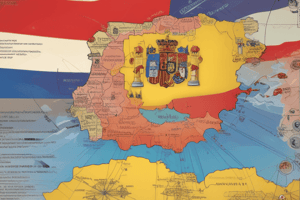Podcast
Questions and Answers
How many Autonomous Communities are recognized by the Spanish Constitution?
How many Autonomous Communities are recognized by the Spanish Constitution?
- 21
- 19
- 15
- 17 (correct)
Which of the following regions has a special system of management and administration?
Which of the following regions has a special system of management and administration?
- Madrid
- Catalonia (correct)
- Sevilla
- Andalusia
Which of the following is NOT a province of Andalusia?
Which of the following is NOT a province of Andalusia?
- Huelva
- Murcia (correct)
- Córdoba
- Cádiz
What is the primary responsibility of provincial councils in Spain?
What is the primary responsibility of provincial councils in Spain?
How are members of provincial councils elected?
How are members of provincial councils elected?
What is the significance of Madrid being a uniprovincial Autonomous Community?
What is the significance of Madrid being a uniprovincial Autonomous Community?
Which of the following statements about the territorial organization of Spain is correct?
Which of the following statements about the territorial organization of Spain is correct?
What is the status of the autonomous cities of Ceuta and Melilla, according to the text?
What is the status of the autonomous cities of Ceuta and Melilla, according to the text?
What is the official language of the Spanish State?
What is the official language of the Spanish State?
How does the Spanish Constitution address the recognition and use of regional languages?
How does the Spanish Constitution address the recognition and use of regional languages?
What does the governance system in Spain reflect?
What does the governance system in Spain reflect?
Flashcards are hidden until you start studying
Study Notes
The Spanish Constitution: A Guide to Spain's Territorial Organization2
Introduction
Understanding the territorial organization of Spain is crucial for appreciating the complex tapestry of regional identities and governance structures within the nation. The Spanish Constitution of 1978 recognizes and guarantees the right to autonomy for the various nationalities and regions that constitute Spain, fostering a diverse yet harmonious system of shared sovereignty.
Regional Government
According to the Constitution, Spain is composed of 17 Autonomous Communities and two autonomous cities, each with varying degrees of autonomy. These communities and cities are divided into provinces, with some being uniprovincial like Madrid. For example, Andalusia consists of eight provinces: Almería, Cádiz, Córdoba, Granada, Huelva, Jaén, Malaga, and Sevilla.
Provincial Administration
Each province typically has a provincial council responsible for assistance and cooperation with municipalities, particularly those with limited resources. These councils are indirectly elected representing various political parties, coalitions, federations, and voter groups.
Regional Bodies
Special systems of management and administration exist in certain regions such as the Basque Country and Catalonia, where historical and cultural differences influence the organization of their governments. Additionally, special considerations apply to the autonomous cities of Ceuta and Melilla, located on the North African coast, which can become self-governing entities upon approval from their respective city councils.
Language Rights
The Spanish Constitution protects the recognition and use of other Spanish languages within their respective autonomous communities, alongside Castilian, which serves as the official language of the State.
Conclusion
While the term "federation" is not explicitly mentioned in the Spanish Constitution, the reality of territorial organization in Spain reveals a wide range of decentralized power arrangements, varying between issues and regions. Overall, the Spanish Constitution and subsequent regional laws create an intricate web of governance that balances central control with regional autonomy, reflecting the nation's multifaceted cultural heritage and diverse demographic makeup.
Studying That Suits You
Use AI to generate personalized quizzes and flashcards to suit your learning preferences.




